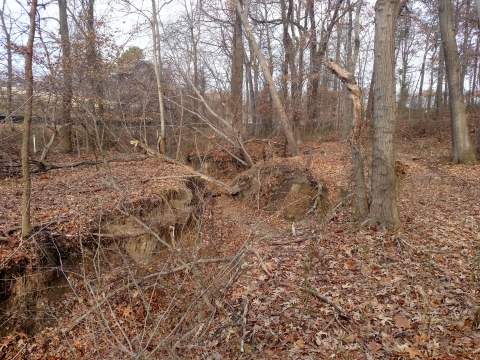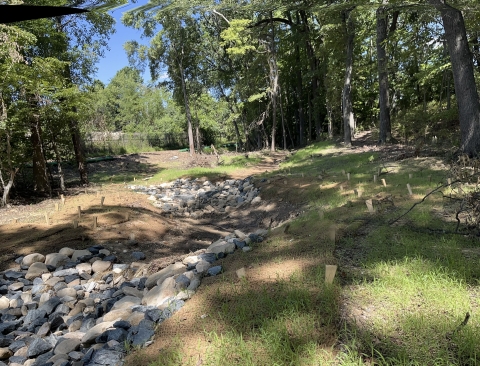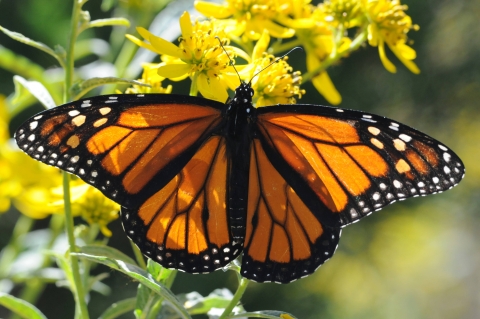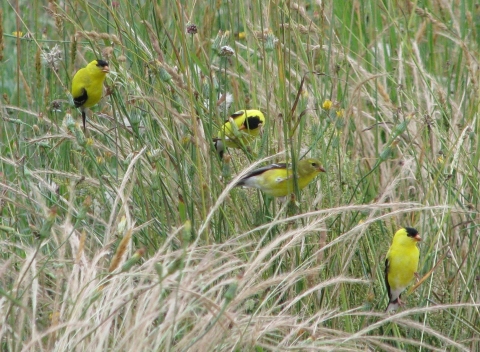Protecting our nation, improving resiliency and conserving wildlife may not seem like goals that work together, but for the Army’s Fort George G. Meade installation in Maryland and the Service’s Chesapeake Bay Field Office, these goals are mutually supportive.
Fort George G. Meade is a highly urbanized installation, being the second largest installation by population, and hosting more than 120 partner agencies. Its 5,200 acres currently include 1,200 acres of forest, 200 acres of wetland, and 200 acres of stormwater detention facilities. In the national capital region, urbanization has converted many native forests and meadows to lawns, which provide little benefit to native wildlife and can attract nuisance wildlife such as resident Canada geese and deer. Forest fragments are often overgrown with vines, which can degrade the forest and minimize use by pollinators, birds, and bats.
Planting native flowering species can be critical to pollinators, insects, herpetofauna, bats, birds, and small mammals. Managing invasive species invasive species
An invasive species is any plant or animal that has spread or been introduced into a new area where they are, or could, cause harm to the environment, economy, or human, animal, or plant health. Their unwelcome presence can destroy ecosystems and cost millions of dollars.
Learn more about invasive species can be daunting, but doing so can restore ecosystem functionality. Conservation actions undertaken at military installations, like Fort George G. Meade, provide essential habitat steppingstones in urban areas, while improving an installation’s climate resiliency.
Assistant Regional Director for Ecological Services, Sharon Marino, recently visited Fort Meade to see some of the ongoing collaborative projects. Welcomed by the Garrison Commander of Fort Meade, Colonel Yolanda Gore, the two toured the installation’s conservation projects and future initiatives with some of the Chesapeake Bay Field Office biologists.
They stopped at a recently completed section of the Severn Run Stream Restoration project which aims to reduce headcuts and restore a natural shape and meander to the streams. Fort Meade is using a watershed approach to provide stability for the stream channels, increase floodplain capacity, and reduce the amount of sediment which is aggregating in areas around road crossings. This restoration improves resiliency by providing flood attenuation and reducing nutrient/sediment deposited, while also restoring aquatic habitat.
The group then visited a future project to create meadow habitat at MacArthur Middle School. Initially proposed as a climate change climate change
Climate change includes both global warming driven by human-induced emissions of greenhouse gases and the resulting large-scale shifts in weather patterns. Though there have been previous periods of climatic change, since the mid-20th century humans have had an unprecedented impact on Earth's climate system and caused change on a global scale.
Learn more about climate change resilience project, put forth by the Assistant Secretary of the Army Installation, Energy, and Environment in partnership with the Service, the meadow will help the installation meet its climate change resiliency goals. The meadow will decrease the installation’s carbon footprint by reducing maintenance activities such as watering and mowing and increase carbon sequestration. MacArthur Middle School benefits too as the on-site habitat will provide outdoor education and stewardship opportunities for students and the school. Educators can use the meadow to teach students about the importance of native plants, at-risk pollinators and their important roles, and various birds that visit there.
Burba Lake, Fort Meade’s most used recreation site, is also slated for improvements. Invasive plant removal activities along stretches of the shoreline will foster the establishment of native plants and provide more access to anglers. The creation of approximately half an acre of meadow on an upland, hilly area will provide recreational birdwatching opportunities, as well as reduce mowing and maintenance in that area. Additionally, pollinator pockets, small areas dedicated to wildflowers, will provide aesthetics for visitors walking the trails around the lake.
Sharon Marino thanked Colonel Gore and her staff for continuing to stand as a great conservation partner by supporting and funding activities restoring natural floodplains, planting native species, promoting forest regeneration, and removing invasive plants. Ms. Marino also acknowledged how Fort Meade’s conservation activities will support climate change resiliency by decreasing their carbon footprint through reduced watering and mowing, increasing carbon sequestration by planting meadow grasses, improving stormwater infiltration, and reducing potential surface flooding.









